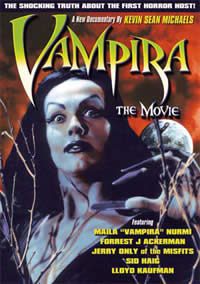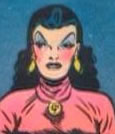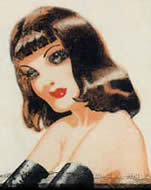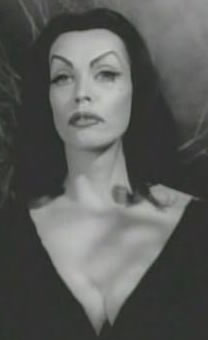
Zombos Says: Good
The year is 1954. It's midnight on a KABC-TV Saturday night. A striking, impossibly wasp-waisted woman in a torn black dress glides down a long, dry ice misty, cobwebbed corridor toward the camera, past unlit candelabras. She stops. Suddenly she screams, then looks at the camera with a devilish gleam in her eyes and says "Screaming relaxes me so."
Vampira's short-lived television show--where, in-between showing gems like White Zombie and forgettable B-fare, she would mix a foaming cocktail to "absolutely kill you," or search for her always lost pet spider, Rollo--opened the door for the many male and female horror hosts that followed, and set the tongue-in-cheek, ghoul-cool standard for hosting still seen today. With her phallic-looking nails, plunging v-neck exposed bosom, and sardonic wit, she presented quite the picture of the succubus every straight guy would love to meet in a darkened room.
Kevin Sean Michaels, in his documentary, Vampira: The Movie, introduces us to Maila Nurmi, Vampira's more normal alter ego. In her eighties now, this succubus may have faded with time, but her wit remains as Nurmi talks about the creation of her influential character, still celebrated by horrorheads everywhere.
The most striking revelation, at least for me, is that she didn't start out the way she ended up. While many of us tend to do that, we, generally, have an inkling as to where we want to end up and aim accordingly. For Nurmi, all she wanted was to be an evangelist. How she missed that path--thank you God from us horror fans--is an interesting mix of plan and chance. Her plan was to make enough money so she could pitch a tent and start preaching. The chance came when she appeared at a costume ball, gets spotted by a producer looking for a good reason people would lose sleep for, and is hired to host a bunch of shlock horror movies that any sane person wouldn't watch in the daytime, let alone midnight on a Saturday night.
 Using her love for comics, cartoonist Charles Addams, and bondage photographer and artist John Willie, Nurmi set about to create a "glamor ghoul." She mixed the sensual power of Terry and the Pirates' Dragon Lady, the ghoulish, bizarre charm of the Addams Family, and the
Using her love for comics, cartoonist Charles Addams, and bondage photographer and artist John Willie, Nurmi set about to create a "glamor ghoul." She mixed the sensual power of Terry and the Pirates' Dragon Lady, the ghoulish, bizarre charm of the Addams Family, and the fetishistic allure of Willie's tightly-bound leather ladies in ecstasy (or distress) to create the first Goth chick on the television screen.
fetishistic allure of Willie's tightly-bound leather ladies in ecstasy (or distress) to create the first Goth chick on the television screen.
In-between the testimonials and remembrances from notable horror personalities like Forrest J. Ackerman, Zacherley, Sid Haig, Lloyd Kaufman, Jerry Only of the Misfits, and many others, Nurmi recalls her sudden fame and subsequent Hollywood blacklisting,, and her associations with Marlon Brando and James Dean. While Vampira may have been a sexy, liberated ghoul, Nurmi shied away from acting because she disliked its competitive nature, and professed to be not as sexually-emancipated as her more seductive twin.
Cassandra Peterson discusses the lawsuit regarding her Elvira, Mistress of the Dark character, whom Nurmi felt looked too much like Vampira, and a good portion of the documentary focuses on Vampira's appearance in Plan 9 From Outer Space, in which Nurmi gives her initial impression of Edward D. Wood Jr. as a "low-born idiot." Unfortunately, little remains of Vampira's KABC-TV show, so Wood's legendary train wreck of a movie is her most-remembered appearance. After reading the script and complaining about her dialog, she and Wood agreed to make her character in the film silent.
The documentary is a welcome and long overdue tribute to an influential figure in the annals of cinematic horror, but it does have its minor faults. Background music is used when silence would have been golden, and too much time is spent on Plan 9 From Outer Space and Wood. The special features play more like "we've got to find something to add" instead of more note-worthy content, though, from the director's commentary it appears there's just not much material available. Nurmi led a hermit-like existence after James Dean's death, and it is quite an accomplishment to get her talking at all. But one pines for more clips from her show, and more personal recollections from those closest to her. But hearing and seeing Maila Nurmi, even after all this time, is to die for. Thanks to her devoted fans that helped make this documentary, we don't have to go that far.
 As Vampira would say at the close of her show, "Bad dreams, darling."
As Vampira would say at the close of her show, "Bad dreams, darling."



Comments